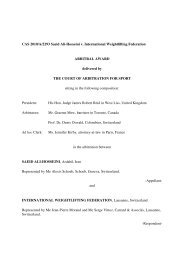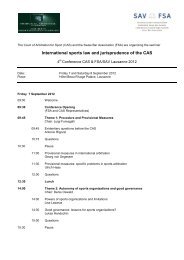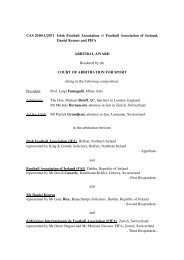(CAS) Bulletin - Tribunal Arbitral du Sport / TAS
(CAS) Bulletin - Tribunal Arbitral du Sport / TAS
(CAS) Bulletin - Tribunal Arbitral du Sport / TAS
Create successful ePaper yourself
Turn your PDF publications into a flip-book with our unique Google optimized e-Paper software.
urine tests performed the evenings of 20 (negative<br />
for clenbuterol) and 21 July 2010 (50 pg/mL of<br />
clenbuterol). However, if the aim was to affect the<br />
results of the blood test, it is reasonable to assume<br />
that the plasma transfusion took place before such<br />
blood test, i.e. at some point between 19.00 (20 July)<br />
and 9.00 (21 July), i.e. in a period of 14 hours.<br />
Dr Rabin comes to this conclusion based on the<br />
following elements:<br />
- according to bodybuilders’ blogs, and also the<br />
report of the Athlete’s defence team, the doses of<br />
clenbuterol used for anabolic purposes are 100-<br />
300 ng daily;<br />
- Dr Rabin’s report posits various timeframes for<br />
the withdrawal of the blood, none of which is<br />
immediately after the last dose of clenbuterol;<br />
- Bearing in mind the negative urine samples of<br />
Mr Contador on the evening of 20 July 2010, one<br />
can conclude that the transfusion of plasma must<br />
have taken place between the evening of 20 July<br />
and the urine test of Mr Contador on the evening<br />
of 21 July 2010 (which resulted in a fi nding of 50<br />
pg/mL clenbuterol); WADA considers, however,<br />
that it is much more likely that Mr Contador<br />
transfused the plasma before (and most probable<br />
shortly before) the blood test on the morning of<br />
21 July. The report therefore runs the calculations<br />
for a transfusion occurring both 12 and 24 hours<br />
before the urine test of the evening of 21 July<br />
2010;<br />
- the report assumes that Mr Contador transfused a<br />
perfectly feasible amount of plasma: 200 mL;<br />
- the report assumes that Mr Contador would<br />
have urinated once every three hours between<br />
the transfusion and the relevant test which is an<br />
extremely fair assumption in favour of the Athlete.<br />
In each of the above examples, more favourable<br />
input data could have been used. However, the report<br />
from Dr Rabin seeks to demonstrate that the blood<br />
transfusion theory is scientifi cally plausible even if<br />
conservative factual assumptions are made.<br />
Prof. Jérome Biollaz reviewed both the expert<br />
report of Dr Martín-Jiménez that was attached to<br />
Mr Contador’s answer and the above-mentioned<br />
expert report of Dr Rabin. Prof. Biollaz reports some<br />
inconsistencies in both reports. However, he comes<br />
to the conclusion that an increased variability will<br />
not change the conclusions of Dr Rabin while in Dr<br />
Martín-Jiménez’s report, the conclusions are likely to<br />
change. More importantly, the incorrect adjustment<br />
made for the plasma/blood ratio by Prof. Martín-<br />
Jiménez invalidates his conclusions.<br />
The fi nal expert report on this matter was prepared<br />
by Prof. Martín-Jiménez in connection with the<br />
second written submission of Mr Contador, taking<br />
into consideration the above remarks from Prof.<br />
Biollaz, who confi rmed at the hearing that Prof.<br />
Martín-Jiménez’ second report was more reliable.<br />
Prof. Martín-Jiménez’ position remains that the<br />
blood transfusion theory is impossible as a matter<br />
of pharmacokinetics. These issues will be dealt with<br />
separately below and are based on the following<br />
arguments:<br />
5.3.3.1 The toxic clenbuterol treatment of the<br />
theoretical donor<br />
According to Prof. Martín-Jiménez, WADA’s model<br />
assumes that the theoretical donor underwent a<br />
course of clenbuterol treatment so extreme that it<br />
would be likely to cause toxicity.<br />
Dr Martín-Jiménez explains in his second report that<br />
“ WADA has provided no justifi cation for using the dose in<br />
question, other than the fact it falls within a range of doses<br />
(100 to 300 ug) I examined as part of a blood transfusion<br />
study I undertook in November 2010. That range of dosage<br />
was never intended or proposed as an accurate dosing range<br />
and was not based on any user information. On the contrary<br />
it was used to provide a widely exaggerated margin of values<br />
in the blood transfusion study in order to emphasise the extent<br />
to which it was unlikely that clenbuterol came from a blood<br />
transfusion. WADA implies that the midpoint of the 100 to<br />
300 ug range (i.e. 200 ug) refl ects standard user dosage. In<br />
fact, as is developed below, a dose of 200 ug per day is an<br />
extreme amount of clenbuterol to ingest, particularly without an<br />
escalated dosage protocol ”.<br />
Dr Martín-Jiménez puts forward a report according<br />
to which a dose of 60 – 120 ug per day is described<br />
to be a dose of clenbuterol typically used by athletes<br />
and bodybuilders. By contrast, WADA’s model<br />
assumed the theoretical donor to have taken 200 ug<br />
of clenbuterol for 21 consecutive days. An example<br />
is given of a person having administered a dose of<br />
clenbuterol of 108.75 ug, but still having suffered<br />
“acute clenbuterol intoxication”.<br />
During the hearing, such assumptions were<br />
rebutted by Dr Rabin as he mentioned that a single<br />
dose of clenbuterol is indeed dangerous, but that<br />
doses can increase after several days of clenbuterol<br />
administration. More specifi cally, it was mentioned<br />
that an ingestion of 200 micrograms of clenbuterol at<br />
Jurisprudence majeure / Leading cases<br />
-<br />
134





